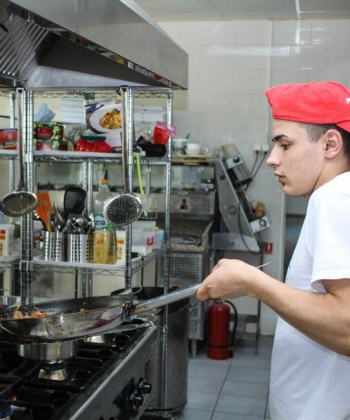Running a successful restaurant is about more than just serving great food. It involves making smart decisions to boost your bottom line.
From managing costs to enhancing customer experience, every detail counts. And, to truly maximize profitability in the restaurant industry, a dual approach is essential.
On one hand, leveraging professional restaurant growth services can provide expert guidance and tailored solutions. On the other, implementing proven, effective strategies is crucial for long-term success.
As a savvy business owner, you should combine both these elements, focusing on every aspect of your operation. By integrating specialized growth services with time-tested methods, you create a powerful synergy that can significantly boost your restaurant’s profitability and ensure sustainable growth in this competitive market.
Now, let’s dive into understanding profit margins, strategies to streamline your maximize every opportunity, and where third party services can help.
Understanding Restaurant Costs and Profit Margins
Understanding exactly what impacts your restaurant’s profits is essential to increasing them.
Key factors include gross and net profits, food, and labor costs. Let’s examine each factor in detail.
Gross Profit Margin
Gross profit margin helps you see how much profit you make after covering the direct costs of your sales. This is the first part of your income statement. For a restaurant, direct costs include food and staff wages.
To calculate the Gross Profit Margin, use this formula:
Gross Profit Margin = Gross Profit/Total Revenue
Operating Profit Margin
The operating profit margin is the second part of your income statement and shows how well you manage indirect costs like marketing, administration, and maintenance.
Even if your gross profit margin is high, managing indirect costs is crucial for your overall success.
To calculate Operating Profit Margin, use this formula:
Operating Profit Margin = Operating Profit/Total Revenue
Where Operating Profit is:
Operating Profit = Gross Profit − Operating Expenses
Net Profit Margin
This is the final measure of profitability. It includes all expenses, such as interest and taxes.
To calculate your Net Profit Margin, you may use this formula:
Net Profit Margin=Net Profit/Total Revenue
Where Net Profit is:
Net Profit= Operating Profit − Interest − Taxes
Food Costs and Profitability
Food costs can be a large part of your expenses, often up to 33% of sales. It’s super important to monitor what you spend on food and drinks. By monitoring these costs closely, you can figure out ways to make more money on each meal.
You can control food costs by changing your menu, getting your kitchen to work smarter, adjusting prices, and reducing waste.
Doing this can help you make more money overall. You can easily track this data through technologies designed to track costs and profit.
Labor Costs
Labor costs can make up 30-50% of your total expenses. High staff turnover, up to 73%, also affects your bottom line. Using technology to manage and plan your workforce can help control these costs.
Smart scheduling can help keep labor costs down while maintaining high service quality. Balancing labor expenses with excellent customer service is crucial for long-term success.
Average Profit Margins
Knowing the average profit margins for different types of restaurants can help you set realistic goals and compare your business to industry standards.
Full-service, quick-service, and catering businesses each have different profit margins. Even the type of business you have and where your restaurant is located can affect how much money you make.
This information helps you evaluate your restaurant’s potential success and make informed decisions to stay competitive.
Full-Service Restaurant Profit Benchmarks
Full-service restaurants typically have profit margins between 2% and 6%. Various factors can affect how much money your restaurant makes. Things like the time of year, how well you treat your customers, how much you charge, how much you pay your staff, and how much food you waste can all make a difference.
Generally, the more customers a restaurant attracts, the higher its profits. Due to their increased workload, these types of restaurants often employ restaurant growth services to help them manage their operations.
Quick-Service Restaurants Profit Benchmark
The profitability of quick-service restaurants varies considerably based on the model used. Here’s a breakdown:
- Food Trucks: Profit margins are typically between 6-9%.
- Fast-Casual Eateries: These restaurants usually see 6-15% margins.
- Pizza Chains: Profit margins generally fall between these two ranges.
Catering Services: Profit Benchmark
Catering businesses generally achieve profit margins of 7-8%.
Revenue comes from multiple sources, including:
- Food and beverage sales
- Merchandise like meal kits and cookbooks
- Special event catering
- Gift card sales
Tips for Boosting Your Restaurant Profit Margin
By following these steps, you can make your restaurant more efficient, enhance the customer experience, and ultimately increase your profits:
Tip #1 – Optimize Your Menu
Think of your menu as a tool to boost your restaurant’s profits. Design it to showcase your most profitable dishes. For example, list items at the top that are higher priced so that other prices seem more affordable. Regularly check which dishes are selling well and which aren’t.
Various restaurant growth services can help you adjust your menu to focus on the popular, high-margin items and remove those that don’t perform well. This helps you make more from each meal served.
Tip #2 – Improve Marketing Efforts
Effective marketing brings more customers through your doors. Use social media to connect with potential diners and share updates or special intimations. Send out email newsletters to keep customers informed about promotions or events.
If you are new to restaurant marketing, consider hiring reliable restaurant growth services to avoid marketing mishaps and manage your budget better.
Tip #3 – Implement Effective Inventory Management
Managing your inventory properly is key to avoiding waste and lost sales. Keep track of how much stock you have and what’s selling well.
Use inventory management tools to help you predict what you’ll need in the future and set up automatic reordering when stock levels get low.
This way, you can avoid overstocking, which leads to waste, or understocking, which may lead to your restaurant missing out on sales.
Tip #4 – Focus on Employee Training
Well-trained staff can make a huge difference. Provide training that covers basic service skills and specific procedures for your restaurant. Update this training regularly to inform everyone about new menu items or promotions. Well-trained employees will perform better, offer better customer service, and help keep everything running smoothly.
Tip #5 – Leverage Technology
Technology has become an invaluable asset for modern restaurants. Systems like point-of-sale terminals can significantly improve customer service and provide detailed sales information.
Apps that allow customers to make reservations or place orders in advance enhance the dining experience. Scheduling software can be used to optimize staffing and create efficient work plans.
By embracing these technological tools, restaurants can operate more smoothly and profitably.
Tip #6 – Enhance Customer Service
Great customer service encourages people to return. Train your staff to greet customers warmly, handle complaints effectively, and ensure a pleasant dining experience.
Empower them to make decisions that improve the customer experience, like offering a free appetizer if there’s a problem. Happy customers are likely to come back and recommend your restaurant to others.
Tip #7 – Track and Utilize Data
Keep a close eye on your restaurant’s finances. Restaurants must closely monitor their spending and other data, especially food and staff salaries.
By tracking how much money is spent in these areas and how often tables are filled, restaurant owners can figure out where they can save money without sacrificing quality. Regularly checking your restaurant’s finances helps control costs and ensure the business is profitable.
Tip #8 – Streamline Production Planning
Careful planning is critical to running a successful kitchen.
By organizing food preparation and using tools to track inventory and create shopping lists, restaurants can operate more smoothly.
This reduces waste, ensures consistent quality, and ultimately boosts profits.
Recap
To bring in increased profits, it is recommended to focus on your menu prices, keep your food choices interesting, and use technology to help you run things smoothly.
Use tools to help you manage your restaurant better and understand what customers want. You can also employ restaurant growth services and specialists to simplify your work and streamline your operations.
Remember, every restaurant is different, so try different things to find what works best for you.



